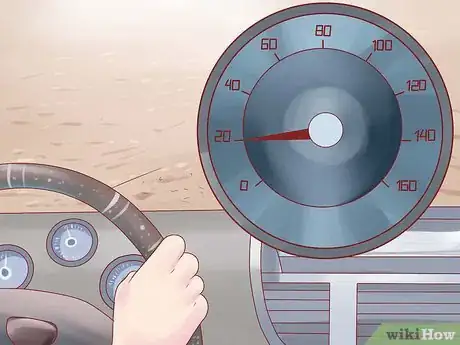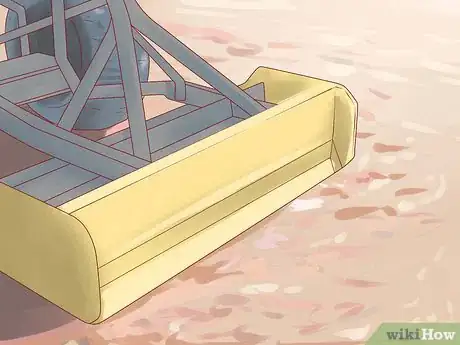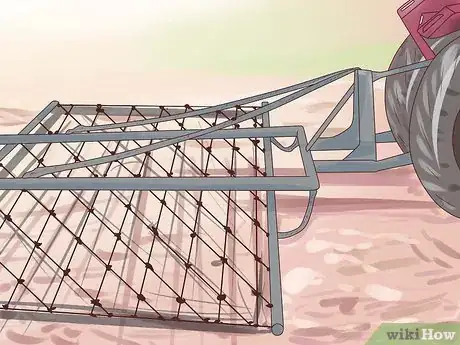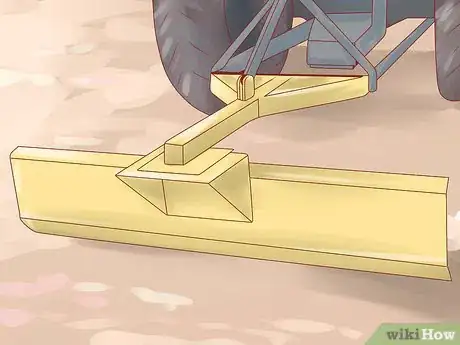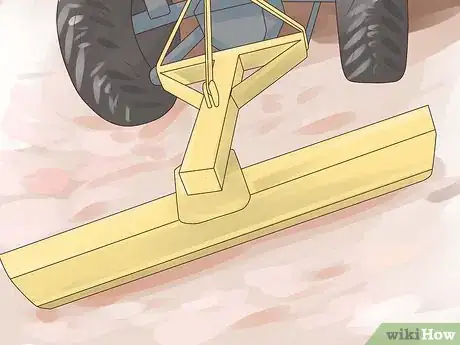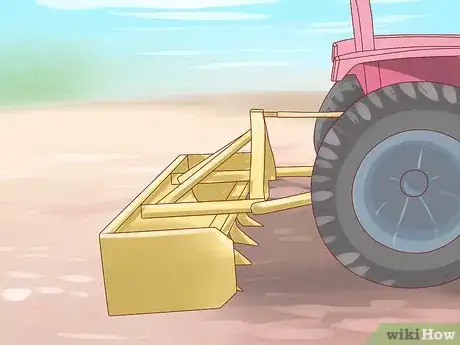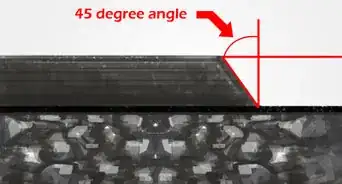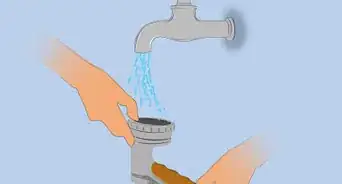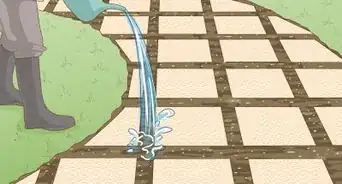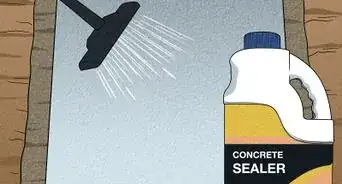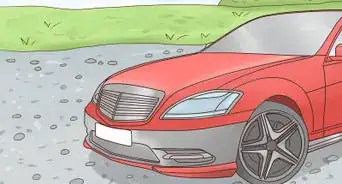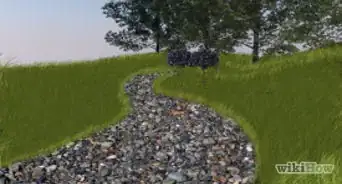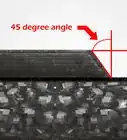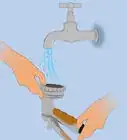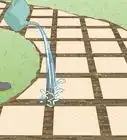wikiHow is a “wiki,” similar to Wikipedia, which means that many of our articles are co-written by multiple authors. To create this article, 10 people, some anonymous, worked to edit and improve it over time.
There are 7 references cited in this article, which can be found at the bottom of the page.
wikiHow marks an article as reader-approved once it receives enough positive feedback. In this case, 92% of readers who voted found the article helpful, earning it our reader-approved status.
This article has been viewed 188,292 times.
Learn more...
After trying lots of approaches to maintain your long gravel drive, you might be wondering how to find out what really works. In this article, you'll discover that basically, a box scraper will take care of about 90% of your needs. The details follow.
Steps
-
1Limit speeds on your driveway/road. If drivers stay below about 20 mph (32 km/h) (hence the 15 mph (24 km/h) sign since everyone speeds), then the road will not "washboard," pothole, or otherwise deteriorate as fast as with higher speeds.[1]
-
2Get a tractor. The tractor is probably the most important (and, most expensive) piece of equipment needed. The front loader is very valuable if you want to move gravel or dirt. It can also be used for some snow plowing.[2]Advertisement
-
3Get a 'box scraper'. It is important to have enough tractor horsepower to pull the selected scraper. Recommendations are usually for about 5hp per foot of scraper width. You can get by with somewhat less horsepower as long as your transmission is strong-enough and you go slower.{{largeimage|Cat Scraper.jpg} "Professional" Version -- Far smaller ones are available for use behind a small tractor.}[3]
-
4Have a chain harrow. A chain harrow is useful for smoothing. You won't need it for every maintenance session, but it is invaluable for smoothing out washboarding during dry periods. You will be limited as to when you can work on the road as it ages -- basically unless you have professional-level equipment or a loose surface, you will need to wait for rain or snow to soften the surface. The harrow can help in the dry season, but the box scraper is the ultimate tool.[4]
-
5Use a grader blade. The grader blade is useful to move gravel or dirt back toward the center of the road. Traffic, snow plowing, and even the box scraper tends to move material out towards the edges of the road. Periodically, if you run the grader blade (set at an angle) along the edges of the road, you can move the edge material back towards the center of the road. This will reduce you costs for gravel for resurfacing. Remove the pin to allow the blade to rotate along the axis of the tractor (the back pin on the grader blade).[5]
-
6Work on the road/driveway. Unless the surface is loose (loose gravel or soft dirt), you will probably have to wait for it to be what is call "juicy" (wet after a soaking rain, basically). The grader blade can be used to return gravel/dirt back toward the middle of the road -- if you don't have much gravel or loose dirt on your drive/road, then this can reduce your costs for buying gravel.[6]
-
7Use the box scraper on the surface. Running the box scraper will do about 90% of the work of maintaining your road. Leave the tines in the "up" position and just use the blade on the bottom to scrape the surface. Depending on the width of your scraper and your road, you simply run up/down the road until the entire surface has been scraped. What happens is that the scraper will pick up gravel and dirt until the box is full. Then, the material will be redeposited on the road in an even layer. This will scrape high points and fill-in low points. For the first time, you may need (want) to run over the surface a few times -- after initially getting the road (relatively) smooth, monthly maintenance for heavily-traveled neighborhood roads and quarterly maintenance for a driveway works well.[7]
- The scraper works well when set to simply level with the road surface. You can adjust the "bite" by raising/lowering the top hitch.
Community Q&A
-
QuestionWhat stones should I use on my dirt road?
 Community AnswerUsually economics will dictate this, but try to stay away from rounded river gravel. You should try to get crushed (angular) aggregate rock from a quarry. Larger rock, say 1 1/2" to 3" could be placed as the bottom layer, or in deep rutted areas since it won't sink into mud/dirt as easily as smaller rock, but your top/final surface should be a 1" to "fines" gradation. It will be easy to grade this with your box blade and the "fines" will choke off and help "seal" the grade. Bear in mind it is important to keep the road/drive either crowned (from the center) or pitched to one side so that rain will shed off, rather than accumulate in low spots. Standing water will contribute to muddy "pumping."
Community AnswerUsually economics will dictate this, but try to stay away from rounded river gravel. You should try to get crushed (angular) aggregate rock from a quarry. Larger rock, say 1 1/2" to 3" could be placed as the bottom layer, or in deep rutted areas since it won't sink into mud/dirt as easily as smaller rock, but your top/final surface should be a 1" to "fines" gradation. It will be easy to grade this with your box blade and the "fines" will choke off and help "seal" the grade. Bear in mind it is important to keep the road/drive either crowned (from the center) or pitched to one side so that rain will shed off, rather than accumulate in low spots. Standing water will contribute to muddy "pumping."
Warnings
- Care is always required when around equipment. Read the directions.⧼thumbs_response⧽
- Follow the directions!⧼thumbs_response⧽
Things You'll Need
- 15 mph (24 km/h) Speed Limit Signs.
- Small tractor with 20hp or more -- 4-wheel-drive, three-point hitch, and front loader are all desirable.
- Box scraper sized to tractor horsepower. Look for one smaller than your horsepower divided by 5.
- Chain harrow.
- Grader blade (optional).
References
- ↑ http://www.specialdistricts.org/index.aspx?page=178
- ↑ https://www.backwoodshome.com/how-to-maintain-a-dirt-road/
- ↑ https://tipsnotebook.deere.com/maintain-gravel-drive-using-box-blade-hydraulic-scarifiers/
- ↑ https://www.greatdayimprovements.com/10-gravel-driveway-maintenance-tips.aspx
- ↑ https://www.greatdayimprovements.com/10-gravel-driveway-maintenance-tips.aspx
- ↑ https://www.greatdayimprovements.com/10-gravel-driveway-maintenance-tips.aspx
- ↑ http://incomingbytes.com/landscaping/how-to-use-a-box-blade-to-level-your-yard/
- The US Department of Agriculture has an excellent booklet on "Environmentally Sensitive Road Maintenance Practices for Dirt and Gravel Roads." This resource, while aimed at environmentally sensitive areas, covers the problems one will have with all roads.
- Penn State University has a Center for Dirt and Gravel Road Studies.
